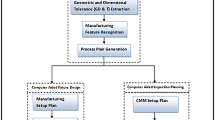Abstract
Computer integrated manufacturing uses computer technology to integrate a manufacturing system through a man-machine interface that fills the gap between manual operation and machine processes. It is clear that a computer vision-based man-machine interface makes a fully automated system possible. The basic challenge of a vision-based interface is how to extract information from digitized images and convert it to machine-friendly “knowledge”. To extract information, then, it often end up to the problem of shape decomposition. This paper proposes an new approach in decomposing compound shapes without prior knowledge of the scene. The proposed algorithm exploits the fact that planar shapes can be completely described by contour segments, and can be decomposed at their maximum concavity into simpler objects. To reduce spurious decomposition, the decomposed segments are merged into groups by analyzing and utilizing the merging hypotheses. The algorithm calculates the linking possibility by weighting the angular differentiation between two segments. The techniques are implemented and are applied to other partial shape matching problems for clustering purposes.
Similar content being viewed by others
References
N. Ansari and E. J. Delp, “Partial shape recognition: a landmark-based approach.”IEEE Trans. Patt. Anal. Machine Intell. 12, pp. 470–483, 1990.
N. Ayache and O. D. Faugeras, “HYPER: a new approach for the recognition and positioning of two-dimensional objects.”IEEE Trans. Pattern Anal. Machine Intell. PAMI-8, pp. 44–54, Jan. 1986.
B. Bhanu and O. D. Faugeras, “Shape matching of two-dimensional objects.”IEEE Trans. Pattern Anal. Machine Intell. PAMI-6, pp. 137–155, Mar. 1984.
S. R. Dubois and F. H. Glanz, “An autoregressive model approach to two-dimensional shape classification.”IEEE Trans. Pattern Anal. Machine Intell. 8(1), pp. 55–66, 1986.
S. A. Dudani, K. J. Breeding, and R. B. McGhee, “Aircraft identification by moment invariants.”IEEE Trans. Computers 26, pp. 39–46, 1977.
J. W. Gorman, O. R. Mitchell, and F. P. Kuhl, “Partial shape recognition using dynamic programming.”IEEE Trans. Patt. Anal. Machine Intell. 10, pp. 257–266, 1988.
W. E. L. Grimson and T. Lozano-P'erez, “Localizing overlapping parts by searching the interpretation tree.”IEEE Trans. Pattern Anal. Machine Intell. PAMI-9, pp. 469–482, Jul. 1987.
J. Hong and H. J. Wolfson, “An improved model-based matching method using footprints,” inProc. IEEE Int. Conf. Patt. Recogn., Rome, Italy, 1988, pp. 72–78.
A. Kalvin, E. Schonberg, J. T. Schwartz, and M. Sharir, “Two-dimensional, model-based, boundary matching using footprints.”Int. J. of Robotics Res. 5, pp. 38–55, 1986.
R. L. Kashyap and R. Chellappa, “Stochastic models for closed boundary analysis: representation and reconstruction.”IEEE Trans. Inform. Theory IT-27, pp. 627–637, 1981.
R. L. Kashyap, “Optimal feature selection and decision rules in classification problems with time series.”IEEE Trans. Inform. Theory IT-24, pp. 281–288, 1978.
T. Knoll and R. C. Jain, “Recognizing partially visible objects using feature indexed hypotheses.”IEEE J. Robotics and Automation RA-2, pp. 3–13, Mar. 1986.
M. Koch and R. Kashyap, “Using polygons to recognize and locate partially occluded objects.”IEEE Trans. Pattern Anal. Machine Intell. PAMI-9(4), pp. 483–494, July 1987.
Y. Lamdan, J. T. Schwartz, and H. J. Wolfson, “Object recognition by affine invariant matching.” inProc. IEEE Int. Conf. Comput. Vision and Patt. Recogn., Ann Arbor, 1988, pp. 335–344.
Y. Lamdan, J. T. Schwartz, and H. J. Wolfson, “On recognition of 3-D objects from 2-D images,” inProc. IEEE Int. Conf. Robotics and Automation, Philadelphia, 1988, pp. 1407–1413.
G. Medioni and Y. Yasumoto, “Corner detection and curve representation using cubic B-spline,” inProc. Int. Conf. on Robotics and Automation, 1986, pp. 764–769.
F. Mokhtarian and A. Mackworth, “Sclaed-based description and recognition of planar curves and two-dimensional shapes.”IEEE Trans. Pattern Anal. Machine Intell. pp. 34–43, Jan. 1986.
E. Persoon and K. S. Fu, “Shape discrimination using Fourier descriptors.”IEEE Trans. Syst., Man, Cybern. 7, pp. 170–179, 1977.
J. J. Reddi, “Radial and angular moment invariants for image identification.”IEEE Trans. Pattern Anal. Machine Intell. 3, pp. 240–242, 1981.
C. W. Richard and H. Hemami, “Identification of the three-dimensional objects using Fourier descriptors of the boundary curve.”IEEE Trans. Syst., Man, Cybern. 4, pp. 371–378, 1974.
A. Rosenfeld and A. C. Kak, 1982.Digital Picture Processing. 2nd ed., vol. 1. Academic Press. New York, 1982.
C. Teh and R. Chin, “On image analysis by the method of moments.”IEEE Trans. Pattern Anal. Machine Intell. 10, pp. 291–310, 1988.
J. L. Turney, T. N. Mudge and R. A. Volz, “Recognizing partially occluded parts.”IEEE Trans. Pattern Anal. Machine Intell. PAMI-7, pp. 410–421, Jul. 1985.
C. Zhan and R. Roskies, “Fourier descriptors for plane closed curves.”IEEE Trans. Compt. 21, pp. 269–281, 1972.
Author information
Authors and Affiliations
Rights and permissions
About this article
Cite this article
Douglas Hung, D.C. Shape disassembly using generating merging probability. Journal of Systems Integration 5, 107–121 (1995). https://doi.org/10.1007/BF01976200
Received:
Revised:
Issue Date:
DOI: https://doi.org/10.1007/BF01976200




